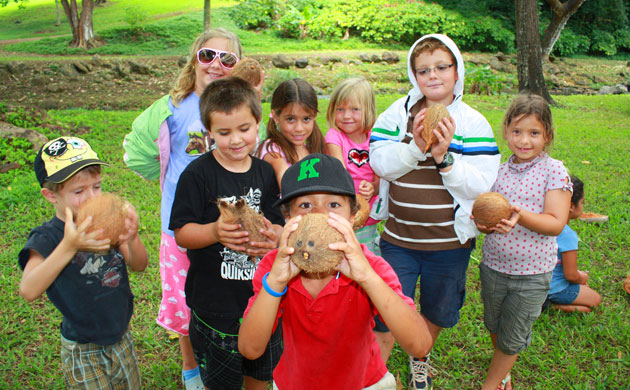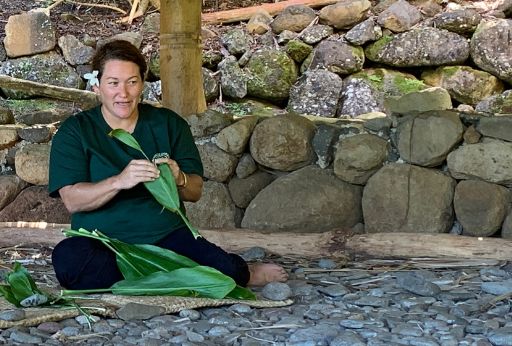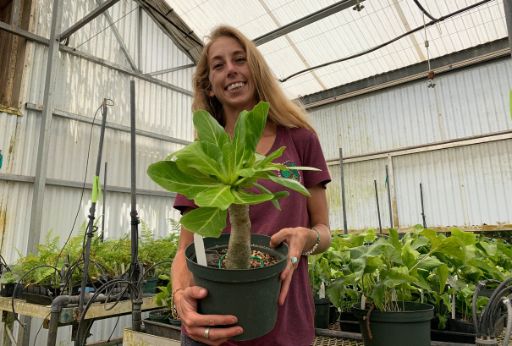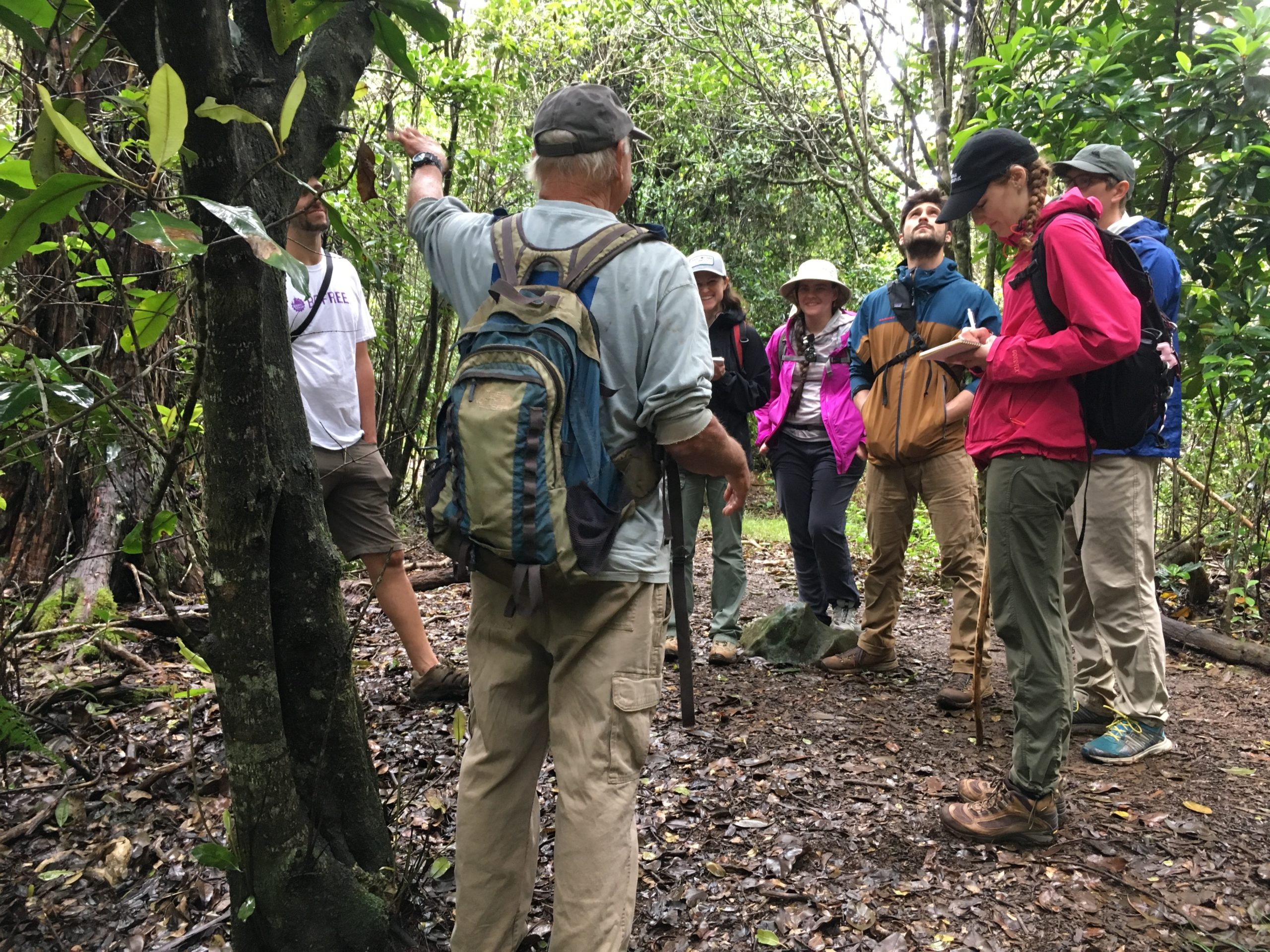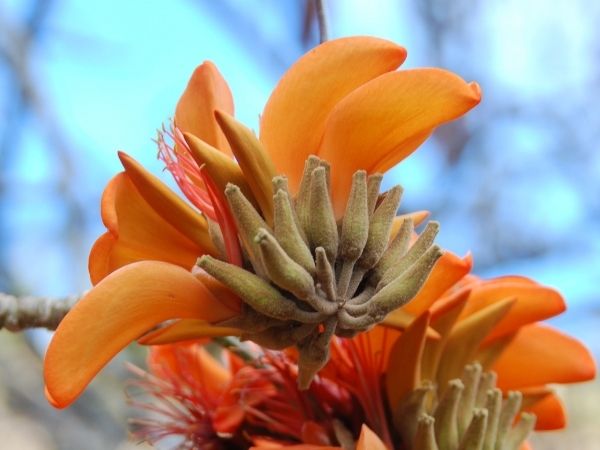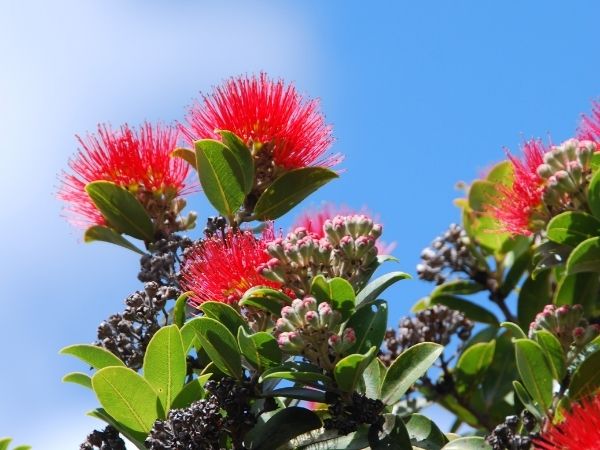Tropical Plant Database - Plant Details
Scaevola glabra
Click on any heading above to view more information about this plant
Conservation Status
- IUCN: endangered
- USFWS: None
Family: GOODENIACEAE
Genus: Scaevola
Species: glabra
Species Author: Hook. & Arn.
Vernacular: Ohe Naupaka,
Synonyms: Camphusia glabra, Camphusia glabra var. kauaiensis, Camphusia kauaiensis, Lobelia glabra, Scaevola kauaiensis
Genus: Scaevola
Species: glabra
Species Author: Hook. & Arn.
Vernacular: Ohe Naupaka,
Synonyms: Camphusia glabra, Camphusia glabra var. kauaiensis, Camphusia kauaiensis, Lobelia glabra, Scaevola kauaiensis
Scaevola glabra is a shrub which grows up to 4 meters tall. The stems are virtually naked with the leaves clustered at the tips of the branches. The leaves are usually 5-15cm long and 2.5-5 cm wide, are wider at the tip than at the base of the leaf, and narrow gradually to the tip and the base of the leaf. The leaves are somewhat leathery and lack hairs on either surface but fine white hairs are present in tufts at the base of the petiole (the stalk connecting the leaf to the stem). It is easy to distinguish `Ohe naupaka from other naupaka species as it is one of only two naupaka species with yellow flowers. The other yellow-flowered species, Scaevola gaudichaudii, has brownish-yellow flowers whereas the flowers of Scaevola glabra are bright yellow. The flowers are similar in shape to other naupaka species: the flower petals are fused together at the base to form a tube that is split open along the upper portion of the flower to form 5 petal lobes. The flowers of `Ohe naupaka are usually 4-5 cm long and curve strongly outward with membranous wings along the margin of the petal lobes. The stamens in which the pollen is produced are contained within the floral tube. The stigma (the surface on which the pollen lands to grow down into the ovary to fertilize the egg) forms a terminal cup at the end of a long stalk called the stigma. The stigma has a ring of hairs underneath it and is longer than the floral tube. The fruit of `Ohe naupaka is fleshy and dark purplish black with multiple seeds inside and is usually 10-14 mm long and 7-10 mm wide.
(Wagner, W. L., Herbst, D. R., and S. H. Sohmer. 1999. Manual of the Flowering Plants of Hawai`i. Revised Edition. Volume 1. Bishop Museum Special Publication 97. University of Hawai`i Press, Bishop Museum Press, Honolulu, Hawai`i.)
(Wagner, W. L., Herbst, D. R., and S. H. Sohmer. 1999. Manual of the Flowering Plants of Hawai`i. Revised Edition. Volume 1. Bishop Museum Special Publication 97. University of Hawai`i Press, Bishop Museum Press, Honolulu, Hawai`i.)
The flowers of the widespread species, Scaevola taccada, which is found in coastal strand vegetation in Hawai`i and the Pacific Islands, were utilized by native Hawaiians to make lei.
(Staples, G. W. and D. R. Herbst. 2005. A Tropical Garden Flora: Plants cultivated in the Hawaiian Islands and other tropical places. Bishop Museum Press, Honolulu, Hawai`i.)
(Staples, G. W. and D. R. Herbst. 2005. A Tropical Garden Flora: Plants cultivated in the Hawaiian Islands and other tropical places. Bishop Museum Press, Honolulu, Hawai`i.)
Scaevola glabra is endemic to the Hawaiian archipelago meaning this is the only region in the world where they are found. `Ohe naupaka is found on Kaua`i and in the Ko`olau Range on O`ahu in wet forest and open bogs at elevations between 200-800 meters.
The genus Scaevola contains approximately 130 species with an Indo-Pacific distribution and a center of diversity in Australia . Nine Scaevola species are found in Hawai`i, 8 of which are endemic. The other species, S. taccada or Naupaka kahakai, has a widespread distribution in tropical and sub-tropical regions on islands in both the Pacific and Indian Oceans. The Hawaiian Scaevola species are thought to be the result of three separate colonizations in Hawai`i: one colonization for S. taccada, a second for S. glabra, and a third for the remaining Hawaiian species. Scaevola glabra is more closely related to two Australia species (S. angulata and S. depauperata) than any of the other Hawaiian species.
(Wagner, W. L., Herbst, D. R., and S. H. Sohmer. 1999. Manual of the Flowering Plants of Hawai`i. Revised Edition. Volume 1. Bishop Museum Special Publication 97. University of Hawai`i Press, Bishop Museum Press, Honolulu, Hawai`i.)
(Staples, G. W. and D. R. Herbst. 2005. A Tropical Garden Flora: Plants cultivated in the Hawaiian Islands and other tropical places. Bishop Museum Press, Honolulu, Hawai`i.)
(Howarth, D. G., et. al., 2003. Phylogenetics of the genus Scaevola (Goodeniaceae): Implication for dispersal patterns across the Pacific Basin and colonization of the Hawaiian Islands. American Journal of Botany 90(6): 915-923.)
The genus Scaevola contains approximately 130 species with an Indo-Pacific distribution and a center of diversity in Australia . Nine Scaevola species are found in Hawai`i, 8 of which are endemic. The other species, S. taccada or Naupaka kahakai, has a widespread distribution in tropical and sub-tropical regions on islands in both the Pacific and Indian Oceans. The Hawaiian Scaevola species are thought to be the result of three separate colonizations in Hawai`i: one colonization for S. taccada, a second for S. glabra, and a third for the remaining Hawaiian species. Scaevola glabra is more closely related to two Australia species (S. angulata and S. depauperata) than any of the other Hawaiian species.
(Wagner, W. L., Herbst, D. R., and S. H. Sohmer. 1999. Manual of the Flowering Plants of Hawai`i. Revised Edition. Volume 1. Bishop Museum Special Publication 97. University of Hawai`i Press, Bishop Museum Press, Honolulu, Hawai`i.)
(Staples, G. W. and D. R. Herbst. 2005. A Tropical Garden Flora: Plants cultivated in the Hawaiian Islands and other tropical places. Bishop Museum Press, Honolulu, Hawai`i.)
(Howarth, D. G., et. al., 2003. Phylogenetics of the genus Scaevola (Goodeniaceae): Implication for dispersal patterns across the Pacific Basin and colonization of the Hawaiian Islands. American Journal of Botany 90(6): 915-923.)
Scaevola glabra is bird pollinated in contrast to the other Hawaiian Scaevola species which are primarily insect-pollinated. Several native honey-creepers (Drepanidae) have been observed visiting and feeding on the nectar produced by Scaevola glabra flowers including the Kaua`i `Amakihi (Hemignathus kauaiensis), `Anianiau (Hemignathus parvus), and `I`iwi (Vestiaria coccinea). The `I`iwi has been observed piercing a hole in the base of the `Ohe naupaka floral tube to obtain the nectar. This practice is known as "nectar-robbing" since nectar is taken from the flower without facilitating pollination (the transfer of pollen from the male to the female flower parts). This may be a new behavior for native bird species which may be associated with the abundance of non-native plant species with long floral tubes that are too long for the beaks of native bird species so the nectar is only accessible to them by piercing the base of the tube.
The fleshy fruit of Scaevola float and are thought to be dispersed by ocean currents as they remain viable after being submerged in salt water. Additionally, the fleshy Scaevola fruit are eaten by birds and may be dispersed after passing through the intestinal tracts of birds.
(Conant, S., H. D. Pratt, and J. Shallengerger, 1998. Reflections on a 1975 expedition to the lost world of the Alaka`i and other notes on the natural history, systematics, and conservation of Kaua`i birds. The Wilson Bulletin, Wilson Ornithological Society 110(1): 1-23.)
(Howarth, D. G., et. al., 2003. Phylogenetics of the genus Scaevola (Goodeniaceae): Implication for dispersal patterns across the Pacific Basin and colonization of the Hawaiian Islands. American Journal of Botany 90(6): 915-923.)
(Mabberley, D. J., 1997. The Plant-Book: A portable dictionary of the vascular plants. Second edition. Cambridge University Press, Cambridge, England.)
(Patterson, R. 1995. Phylogenetic analysis of Hawaiian and other Pacific species of Scaevola (Goodeniaceae), pp 363-378 in Wagner, W. L. and V. A. Funk eds. Hawaiian Biogeography: evolution on a hot spot archipelago. Smithsonian Institution Press, Washington and London.)
The fleshy fruit of Scaevola float and are thought to be dispersed by ocean currents as they remain viable after being submerged in salt water. Additionally, the fleshy Scaevola fruit are eaten by birds and may be dispersed after passing through the intestinal tracts of birds.
(Conant, S., H. D. Pratt, and J. Shallengerger, 1998. Reflections on a 1975 expedition to the lost world of the Alaka`i and other notes on the natural history, systematics, and conservation of Kaua`i birds. The Wilson Bulletin, Wilson Ornithological Society 110(1): 1-23.)
(Howarth, D. G., et. al., 2003. Phylogenetics of the genus Scaevola (Goodeniaceae): Implication for dispersal patterns across the Pacific Basin and colonization of the Hawaiian Islands. American Journal of Botany 90(6): 915-923.)
(Mabberley, D. J., 1997. The Plant-Book: A portable dictionary of the vascular plants. Second edition. Cambridge University Press, Cambridge, England.)
(Patterson, R. 1995. Phylogenetic analysis of Hawaiian and other Pacific species of Scaevola (Goodeniaceae), pp 363-378 in Wagner, W. L. and V. A. Funk eds. Hawaiian Biogeography: evolution on a hot spot archipelago. Smithsonian Institution Press, Washington and London.)
The generic name Scaevola is derived from the Greek word "scaevus" meaning "lefthanded" or "awkward". This may be in reference to Scaevola flowers which appear incomplete or awkward.
(Wagner, W. L., Herbst, D. R., and S. H. Sohmer. 1999. Manual of the Flowering Plants of Hawai`i. Revised Edition. Volume 1. Bishop Museum Special Publication 97. University of Hawai`i Press, Bishop Museum Press, Honolulu, Hawai`i.)
(Wagner, W. L., Herbst, D. R., and S. H. Sohmer. 1999. Manual of the Flowering Plants of Hawai`i. Revised Edition. Volume 1. Bishop Museum Special Publication 97. University of Hawai`i Press, Bishop Museum Press, Honolulu, Hawai`i.)
Scaevola glabra is morphologically quite distinct from the other Hawaiian species with flowers that lack bracts, presence of a long, fleshy floral tube which is strongly curved, and large fruit. Scaevola glabra is a tetraploid species which has thirty-two chromosomes (2n=32) whereas the other Hawaiian Scaevola species contain only sixteen chromosomes (2n=16) and are therefore considered diploid. This may result from an historical duplication in the number of chromosomes as a result of failure in segregation of homologous chromosomes during meiosis in the production of gametes.
- 033215 - collected by George Gillett in 1964
- 033220 - collected by George Gillett in 1964
- 033218 - collected by George Gillett in 1964
- 005412 - collected by W. L. Stern in 1971
- 005411 - collected by Derral Herbst in 1971
- 005410 - collected by Derral Herbst in 1972
- 080270 - collected by Derral Herbst in 1972
- 005424 - collected by John J. Fay in 1974
- 005416 - collected by Steven P. Darwin in 1975
- 005415 - collected by Steven P. Darwin in 1975
- 005423 - collected by Steven P. Darwin in 1975
- 005422 - collected by Thomas B. Croat in 1978
- 005421 - collected by Tim Flynn in 1984
- 005414 - collected by T. G. Lammers in 1984
- 005413 - collected by Steve Perlman in 1987
- 005420 - collected by David H. Lorence in 1987
- 005419 - collected by David H. Lorence in 1987
- 005418 - collected by K. R. Wood in 1987
- 011717 - collected by Steve Perlman in 1989
- 003225 - collected by David H. Lorence in 1989
- 001737 - collected by Tim Flynn in 1989
- 007900 - collected by Tim Flynn in 1990
- 033201 - collected by K. R. Wood in 1991
- 010141 - collected by David H. Lorence in 1991
- 011928 - collected by K. R. Wood in 1991
- 033213 - collected by K. R. Wood in 1993
- 033204 - collected by K. R. Wood in 1996
- 040319 - collected by K. R. Wood in 1996
- 087147 - collected by K. R. Wood in 2000
- 045669 - collected by Steve Perlman in 2003
- 042570 - collected by Michael Kiehn in 2003
- Unassigned - collected by John R. Clark in 2004
- 058163 - collected by Natalia Tangalin in 2005
- 047769 - collected by K. R. Wood in 2006
- S062137 - collected by K. R. Wood in 2006
- 047243 - collected by Mary Merello in 2008
- 049103 - collected by Clay Trauernicht in 2008
- Unassigned - collected by Clay Trauernicht in 2008
- 055208 - collected by Natalia Tangalin in 2008
- 048744 - collected by Clay Trauernicht in 2009
- 065537 - collected by K. R. Wood in 2010
- 062982 - collected by K. R. Wood in 2012
- 065072 - collected by Steve Perlman in 2012
- 064989 - collected by Steve Perlman in 2012
- 065231 - collected by J.C. Watson in 2012
- 072454 - collected by Natalia Tangalin in 2013
- 085370 - collected by K. R. Wood in 2014
- 070581 - collected by Jesse Adams in 2014
- 082546 - collected by K. R. Wood in 2014
- 084884 - collected by K. R. Wood in 2015
- Unassigned - collected by Dustin Wolkis in 2016
- S089945 - collected by Dustin Wolkis in 2016
- 079889 - collected by K. R. Wood in 2018
- 079977 - collected by K. R. Wood in 2019
- 086705 - collected by K. R. Wood in 2020
- 083550 - collected by K. R. Wood in 2020
- 087127 - collected by K. R. Wood in 2021
- 085956 - collected by K. R. Wood in 2021
- 092632 - collected by KPEPP in 2022
- 092885 - collected by KPEPP in 2022
- 092995 - collected by Adam M. Williams in 2022
- Unassigned - collected by K. R. Wood in 2023
- 095802 - collected by K. R. Wood in 2024
- 095099 - collected by KPEPP in 2024
We currently have 64 herbarium specimens for Scaevola glabra in our collection. Click on any specimen below to view the herbarium sheet data.
.svg)


